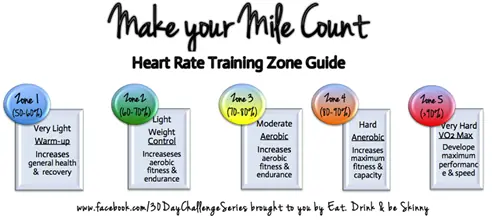Heart Rate and Heart-Rate Training Zone
In order for your body to benefit from the cardiovascular exercise, you need to get your heart pumping. First, you need to know your maximum heart rate. Then you should know your heart-rate training zone. Here's how:
Maximum Heart Rate
There are two ways to get your maximum heart rate. The first way is easy. Take 220 and subtract your age. Here's an example:
Age: 30
Equation: 220 — 30 = 190 (max heart rate)
The other way, which is a bit more accurate, is to do a stress test. To do this, find a good hill. Jog a few laps to warm up your legs. Once you're ready, sprint up that hill till you feel like you're going to keel over. Depending on your fitness and the steepness of the hill, this may not take very long. Immediately take your heart rate for a 10-second count and multiply that number by six. Jot that number down. Do this three more times. Then find the average number from your list. This is your true max heart rate.
Heart-Rate Training Zone

Cardiovascular exercises are broken into zones 1 through 5, all resulting in different benefits. Use the chart above as a reference to help you figure out your interval paces.
If your max heart rate is 190, and you want to train at a moderate pace to increase your aerobic fitness and endurance, then you want your heart rate to be at 70 to 80 percent of its max. You need to multiply 190 by 70 percent and 80 percent to find your zone.
Example:
190 x 70 percent = 133
190 x 80 percent = 152
This means you want your heart to beat between 133 and 152 times per minute. Or, between 22 and 25 times for a 10-second count.
Now that you have your numbers and targets, track them! Get a heart-rate monitor or manually track your heart rate at the peak of your exercise to ensure you are getting your blood pumping.
More: Understanding Your Heart Rates and Exercise



